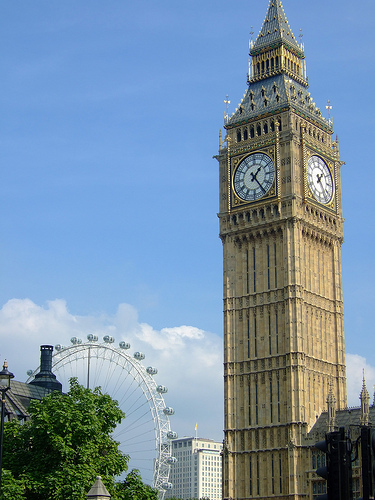Big Ben
Used in films and television to signify to the audience that they are viewing scenes set in the city of London, Big Ben, as the Elizabethan Tower is more commonly called has to be the most iconic symbol of London. Its image appears on tourist merchandise and around 80% of postcards bought in the city. It is a building that is recognised the world over as sitting firmly in the heart of London. Technically to refer to this building as Big Ben is wholly inaccurate as in truth, it is the large bell inside the clock tower that actually bears the name. A bell that weights in excess of 13 tons and chimes out not only the hours of the day, but is used nationally to ring in the New Year.

This iconic clock tower features four clock faces so that the time can be seen from all directions, each face measures a full seven metres across, and is swept by hands that weigh in the region of 100kg each. Each clock face is made up from 312 individual pieces of glass. Though all of the clock faces are illuminated at night there is a special light that comes on above each face of the clock when parliament is in session in the palace of Westminster. This huge, multi faceted clock which is famous throughout the world is in fact kept true to Greenwich meantime by means of a stack of coins which are positioned upon the giant pendulum. This is one clock that has rarely stopped, even during the blitz the clock tower and Big Ben survived and continued to strike the hours as usual.
The History Behind Big Ben
When the Palace of Westminster succumbed to the ravages of fire in 1834, it was decided that the new buildings that would be home to the Houses of Parliament would include a tower building and a clock and designs were drawn up in 1844 for the building we have today. Big Ben was not the first bell to be installed in the tower, the first bell that was put in place cracked beyond repair and was subsequently melted down and recast. The chimes that we recognise today first rang out across the city on May 31st 1859, however this bell also cracked. Rather than melt the bell down and re-forge it, the size of the bell hammer was changed to a lighter model and the bell turned so that the hammer would hit an undamaged section, and this is how it remains today.
Why Big Ben?
There are only two theories behind the naming of the bell, a name which has become recognisable around the world for referring to the famous clock tower. One theory is that the bell was named for Sir Benjamin Hall. He was the original commissioner of works and was known to all of his friends, including those in the Houses of Parliament as ‘Big Ben’. The second theory is linked to a past heavyweight boxing champion named Benjamin Caunt, also widely known to all as ‘Big Ben’, a name that was then bestowed upon anything that was the biggest, heaviest or most powerful in its class.

